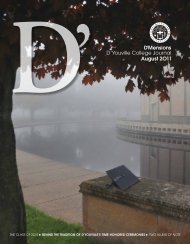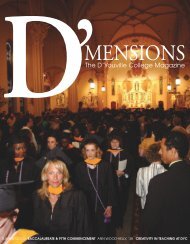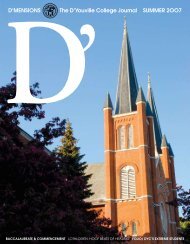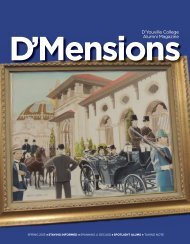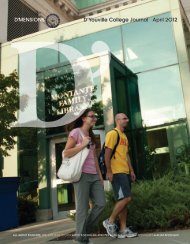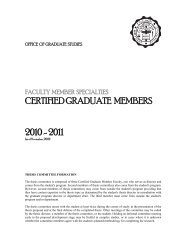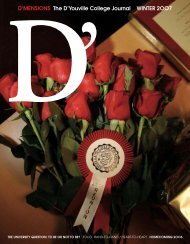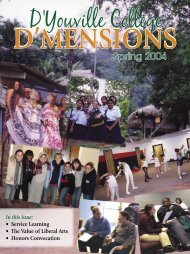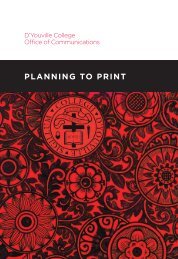d'mensions/the d'youville college Journal summer 2oo6
d'mensions/the d'youville college Journal summer 2oo6
d'mensions/the d'youville college Journal summer 2oo6
- No tags were found...
You also want an ePaper? Increase the reach of your titles
YUMPU automatically turns print PDFs into web optimized ePapers that Google loves.
“Lucky enough,” she said, “Dr. Paulino has worked before<br />
with governments in transition from one system to ano<strong>the</strong>r<br />
—in <strong>the</strong> Dominican Republic, Zimbabwe, and Nicaragua.<br />
He was able to give us insight into how to help. He told us<br />
that D’Youville College and its mission is much <strong>the</strong> same as<br />
we were talking about: <strong>the</strong> mission of being <strong>the</strong> voice of <strong>the</strong><br />
voiceless; in o<strong>the</strong>r words, being <strong>the</strong> voice of <strong>the</strong> poor.”<br />
“I am proud of my D’Youville education:<br />
I am learning to be a person of o<strong>the</strong>rs.”<br />
-Sr. Theresina, IHSA<br />
Warming to <strong>the</strong> subject, she continued, “And poverty doesn’t<br />
come in just not having money; in our case poverty is more<br />
than that. It comes in not having education, and not just <strong>the</strong><br />
lack of education but lack of <strong>the</strong> right of access to education<br />
for girls.” She recalled, “I remember at this school where I<br />
taught, a girl called Ka<strong>the</strong>rine had finished her fourth year<br />
and was to come back to finish her fifth year, but her bro<strong>the</strong>r<br />
was in ano<strong>the</strong>r school. He had passed his exams and was also<br />
going into his fifth year. Now, <strong>the</strong> parents didn’t have enough<br />
money to support both kids to continue <strong>the</strong>ir fifth year of high<br />
school, so <strong>the</strong> solution was Ka<strong>the</strong>rine was to stay out so that<br />
he bro<strong>the</strong>r could continue with his studies.”<br />
“Then ano<strong>the</strong>r case was a girl called Joyce. She came to<br />
school, she took <strong>the</strong> interview to join that year, she passed <strong>the</strong><br />
interview, but she was not to come to school because her fa<strong>the</strong>r<br />
said, ‘Why should I bo<strong>the</strong>r myself to send a girl to school’ So<br />
Joyce had to stay home, until Sr. Susanna Musabi, director of<br />
education of our school, wrote a letter to <strong>the</strong> fa<strong>the</strong>r saying he<br />
must come within one week with money for Joyce’s uniforms,<br />
books, and food or she would report him to <strong>the</strong> government.<br />
The fa<strong>the</strong>r came in.”<br />
In Tanzania, <strong>the</strong> low value granted to girls’ education<br />
discourages families from investing in <strong>the</strong>m. Families<br />
prefer to invest in boys’ education, reasoning that in <strong>the</strong>ir<br />
predominantly patrilineal communities, boys guarantee <strong>the</strong><br />
continuation of lineage, while girls, once <strong>the</strong>y are married,<br />
continue <strong>the</strong> lineage of <strong>the</strong>ir husbands, often in ano<strong>the</strong>r<br />
community. As a result, girls are subjected to dehumanizing<br />
transactions, trading <strong>the</strong>m for economic gain. This age-long<br />
practice is viewed as marriage bondage, of enslaving women<br />
by exchanging <strong>the</strong>m for cows or cash. However, bride-prices<br />
is a contentious phenomenon in African culture and one not<br />
easily dismissed.<br />
Sr. Theresina explained, “If you have a girl who is maybe ten<br />
to fifteen, <strong>the</strong> first thing you have in your head is she should<br />
Top: The project team: Dr. Amable Paulino, chair, business<br />
department (seated left), is <strong>the</strong> senior educational advisor of <strong>the</strong><br />
Mara school project. He is shown with Sr. Benedicta Wasonga,<br />
IHSA, I.B., ’07 (seated), Sr. Theresina Magoti, IHSA, Ed., ’06<br />
(standing left), and Sr. Ifigenia Camilius, FSSB, I.A., ’07. They<br />
are joined by Patricia Van Dyke ’52.<br />
Above: The Immaculate Heart Sisters of Africa, shown with <strong>the</strong>ir<br />
parish priest (left rear), have been teaching in Tanzania since<br />
1955.<br />
Opposite page: These three youngsters, whose parents died of<br />
HIV/AIDS, now live with <strong>the</strong>ir grandparents and attend Mara<br />
Region schools. The boy typically looks confident, while his sisters<br />
appear less so, reflecting a social system in which females often<br />
are regarded as chattel.<br />
15




